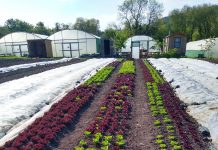Good watering is a precise art and one worth mastering, as the right amount of water makes a big difference to crop growth. Above all, avoid over-watering, especially on germinating seeds and seedlings. Factors to consider are: how warm is it, what is your soil, and what plant are you watering?
How warm is it? Generally August is the warmest moth of the year, and a fortnight without rain does call for some watering. Even so, in a sunny August the nights can dive to 6 degrees after being 25 degrees in the day. A cloudy week often gives a warmer average temperature than a sunny one, and is very good for most crops, as we saw last year.
We have all seen how much more plants grow after rain than after being watered. It is humid air they most like, as it eases their transpiration. So even a slight drizzle, which doesn’t even wet the soil, counts for a lot with the plant. Windy weather is bad news all round, as it puts the plant under strain, and evaporates water from the soil.
What is your soil? In the summer, half of soil water loss is upwards by evaporation. Whatever your soil, a thick layer of mulch will help your soil retain moisture, as well as feeding your plants.
Not digging will reduce the speed water drains away downwards after rain, when so much goes down the big cracks you have made. This was noticeable this spring, when we had little rain. It is much easier to get a good germination if you don’t rotavate. Neither seed nor rain will disappear down cracks in the soil.
What are you watering? Established plants should be encouraged to get their roots working hard, and not watered too often. In a healthy soil, roots develop a symbiotic relationship with mycorrhizae. These are fungi that form long strands in the soil, feeding the plant with water and nutrients in return for feed. In this way the roots reach much further than you think, and water is being extracted from every corner of your soil.
The leaves of all plants capture the dew and hold the moisture in their leaves which, together with the fact that when they fully cover the soil, reduces evaporation from it.
Some crops need more water than others. Celeriac and courgette like moist soil. In the driest of dry spells, my 3 courgette plants, on 4 square metres of soil, will never get more than a gallon of water. Carrots growing in my clay soil often split if there is heavy rain after a dry spell, so I usually water them lightly after a dry week.
In my greenhouse I now water my tomatoes and cucumbers every other day. They have a thick layer of manure on top of the soil to help hold the moisture in. When it is dry and hot, I will use up to 3 gallons of water in my 12’ x 8’ greenhouse. If it is wet outside, and the air is humid, I cut this down by half.
Seedlings do not have their roots deep and will appreciate gentle watering. So often I see people watering from afar with a hosepipe, which will blast most seeds out of the ground, and bruise small seedlings. The soil really isn’t made to get an inch of water in 3 seconds, and doesn’t like it. Water gently, keeping the spout of the watering can as close to the ground as possible. This is particularly true if watering newly sown seeds, heavy irregular watering will easily wash them down a crack, or drown them. Bad germination is often over-watering. Seeds need air as well as water. It is best to water the soil well before sowing the seed, and from then on merely moisten the soil just enough to stop it cracking.
Don’t over water! I prefer a watering can to a hose or sprinkler. People with sprinkler systems often get trigger happy. I used to have one and left it on overnight by mistake, which is wasteful and bad for both the soil, the plants and the environment. Water in the morning if you have any slugs, so that the surface will dry off in the day before slug breakfast time.
So, the message is not to be wasteful, your plants don’t like it.








